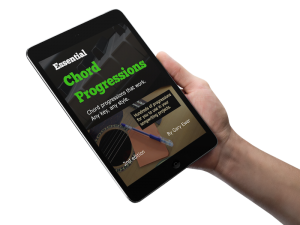You know that there are many songs where verses and choruses are in different keys. When it comes to questions about chord progressions that I receive, the most common kinds of questions relate to that issue: how to get from one key to another in a typical song.
It’s not unusual for a song to change key somewhere, but keep in mind that the most common situation is actually to start and end in the same key. And some songs, like the enormously successful “Uptown Funk” (Mark Ronson, Jeff Bhasker, et al), key of D minor (D Dorian, actually), keep it very simple, featuring only two chords: Dm and G, from the beginning to the end.
 “The Essential Secrets of Songwriting” ebook bundle packages will show you how to write great songs, harmonize your melodies, and will give you hundreds of chord progressions in the process.
“The Essential Secrets of Songwriting” ebook bundle packages will show you how to write great songs, harmonize your melodies, and will give you hundreds of chord progressions in the process.
For songs that do change key, the most common key change is the minor-to-major switch. That is, a song that starts with a minor key verse, then switches to the relative major for the chorus. If the song uses a bridge, you’ll find that more often than not it will start in the relative minor, but quickly (by the 5th or 6th bar of that bridge) start wandering back to major for those final chorus repeats:

That kind of shifting key, from C major to A minor and back again, is a wonderful way to allow musical energy to ebb and flow. There’s a brightness that comes when the listener hears that shift from minor to major, and the relative major-minor relationship is probably the most common way to achieve that.
So a song using that plan might use the following chord progressions:
TYPICAL EXAMPLE:
- VERSE: Am G F Em |Am G F Em |Dm F G F |Dm F G____|| (optional repeat)
- CHORUS: C F Dm G |D F Dm G| Am Em F C |Am Em F G|| (optional repeat)
- BRIDGE: Am Em F Dm |Am EM F Dm |Am G F Am Bb F G____||
There are other relationships to consider, like keeping the verse and chorus in the same key, but moving to the ii-chord as a key centre in the bridge, as John Lennon does in “Real Love”:
- VERSE: E G#m/D# C#m B+ |A F#m B E A E|
- CHORUS: E Am E Am…
- BRIDGE (Instrumental break): F#m C# F#m Bsus4 B Bsus4 B
In any case, the benefit of a key change is that the audience experiences the pleasant tension of feeling the music wander away from the home key, and then the comfort of eventually hearing the home key return.
Switching Keys
So how do you make sure that moving from one key to another is done smoothly and without any kind of unpleasant “hiccup”? Your most important responsibility there is to look at the final chord or two of one section, and then be sure that they move smoothly to the new key.
It’s common for the beginning of a bridge to use a so-called abrupt modulation, in which the switch to minor isn’t hinted at. You’ll hear that at the start of the instrumental bridge for “Real Love” is in F# minor, but there was no indication at the end of the chorus that a key change was coming.
But for switching from minor verse to major chorus, you’ll often hear a more considered preparation of the new key. In the “TYPICAL EXAMPLE” shown above, notice that even though the progression is in A minor, the end of the progression looks more and more like C major, paving the way for an easy transition to that key.
Tips
If you’re considering other kinds of key relationships in your songwriting, remember the following:
- Smoother transitions are always safer than abrupt ones.
- Don’t always play it safe. 😉
- Minor to major (verse to chorus) is far more common, and often more successful, than major to minor.
- For songs that use the same progression in the verse and chorus (or for any kind of refreshing moment in a song), consider bumping the chorus up into a new, higher key. Moving to a lower chorus key can work as well, as long as the melody moves higher. (Example: “Penny Lane”, which moves from a B major verse to an A major chorus).
- For songs where verse and chorus are in the same key, definitely consider switching to a new key for a bridge.
 Written by Gary Ewer. Follow Gary on Twitter.
Written by Gary Ewer. Follow Gary on Twitter.
 Looking for lists of progressions you can use in your own songs? “The Essential Secrets of Songwriting” eBook Bundle has 2 main collections, plus eBooks on how to harmonize your own melodies, and more.
Looking for lists of progressions you can use in your own songs? “The Essential Secrets of Songwriting” eBook Bundle has 2 main collections, plus eBooks on how to harmonize your own melodies, and more.











Pingback: Tips and Tricks: When You Want to Change Key in the Middle | The Essential Secrets of Songwriting